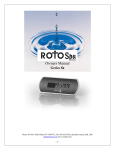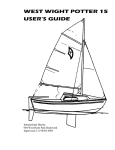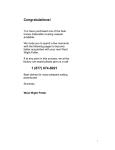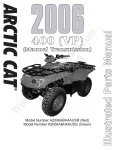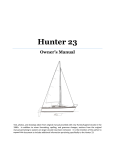Download 1977 Catalina 22 Owners Manual
Transcript
1977 Catalina 22 Owners Manual Foreword This manual will serve as a guide to the features that are special to the Catalina 22 model. The manufacturer has designed this manual to be used in conjunction with a GENERAL HANDBOOK. Before or after reading this manual, please be sure to read the GENERAL HANDBOOK which discusses general care and maintenance procedures that are applicable to all our boat models, and also includes practical sailing and safety tips. The manufacturer would like to take this opportunity to wish you season after season of sailing enjoyment in your new Catalina 22. We have prepared these notes with that goal in mind, believing that knowledge of your boat and awareness of safety procedures will lead to increased sailing pleasure for you and your family. CONTENTS • • • • • • • • • Foreword Commissioning Stepping the Mast Rigging and Launching Pop Top Instructions Retractable-Keel Model Instructions Hauling out the Retractable-Keel Model Tuning Your Mast Fine Tuning While Sailing • • • • • • • • • Winterizing the Boat Anchors Outboard Engines Trailering Battery and Wiring Schematic Diagram Class Association C-22 Terminology Closing Words COMMISSIONING The launching and rigging of the Catalina 22 is best handled by experienced boat yard personnel under direction of your authorized dealer. However, if you are not in a location where he can assist you, the steps to prepare your new boat for sailing are not difficult, and you can do it yourself by reading this manual and the General Handbook and following the recommended procedures. Be sure to read the section on trailering and launching (pages 3 and 9 in this book and pages 6 through 11 in the General Handbook) before towing your boat to the launching site. STEPPING THE MAST When trailering your boat, always try to undo as little rigging as possible. For instance, in the case of the Catalina 22 it is necessary only to undo the two forward lower shrouds and the forestay before lowering the mast. 1. Before raising mast, ensure that halyards are neatly tied down and that they are on proper sides of the spreaders. You should never attempt to raise the mast unless the upper shrouds (those that pass over the spreaders) and the aft lower shrouds are attached to the deck fittings and the turnbuckles well "started" into their barrels. The turnbuckles must not be completely tightened however, because 2. 3. 4. 5. slack is needed in the shrouds to enable the mast to be fully raised. The backstay should be attached to the transom fitting. The upper shrouds, aft lower shrouds, and backstay will keep the mast from falling over when it's raised, therefore, all of these must be attached to their respective deck fittings before the mast is raised. Make sure that the shrouds and stays are not fouled. Backstay should lie clear of the transom. You may step the mast on land or while the boat is in the water. It seems to be easier on land because the boat holds still. Also, it keeps other boaters from getting impatient while they wait for you to move out of the launch area so that they may then launch their boat. Walk the mast aft and drop mast foot into tabernacle located on top of the deck, keeping mast in center line of boat. Do not allow the mast to pry up on the tabernacle as it may break the prongs on the tabernacle due to the unnatural pressure. One crew member should pull on a line tied securely to the forestay while another pushes up on mast and walks from cockpit forward. With the mast erect, attach the forestay and forward lower shrouds. RIGGING AND LAUNCHING The fixed-keel model Catalina 22 should be launched by experienced persons with the aid of a hoist and slings. The local dealer and boat yard possessing such hoists can advise you about this and will handle the operation for you. Retractable-keel models are also often launched using a hoist and slings. Either model boat can be hoist launched with the mast stepped and in place in the vertical position by merely releasing the backstay at the turnbuckle where it attaches to the transom. However, the remainder of the mast's shrouds and forward stay must be properly connected to their deck fittings. Most importantly, check that the aft lower shrouds are secure since they will keep the mast from falling forward when the aft stay is disconnected from the transom. The rigging procedures and mast stepping instructions covered under the section "RIGGING FOR LAUNCHING" in the GENERAL HANDBOOK and under the section "STEPPING THE MAST" in this manual also apply to both models of the Catalina 22. Ramp launching instructions for the retractable-keel Catalina 22 appear in the GENERAL HANDBOOK under the section titled "RAMP LAUNCHING OF TRAILERABLE BOATS." Please review all those parts which apply before launching your boat. RETRACTABLE-KEEL OWNERS PLEASE NOTE: Since you will be traveling with the retractable-keel lowered completely into the rubber "V" support wedge located on the center of the trailer, you must remember to crank up the keel the last few inches before you attempt to launch. Otherwise, the boat will not slide off the trailer. (Release locking bolt on keel before cranking.) POP TOP INSTRUCTIONS If your boat was ordered with a "pop top" hatch, the following notes will aid in its operation: First of all, the pop top can be used in two different positions. When the pop top is in the down position, the smaller sliding hatch serves as access to the cabin. When the pop top is in the up position, access to the cabin is greatly increased and of course, so is the available head room. To put the pop top in the up position, you must go inside the cabin. The top is raised by lifting upward and forward at the same time. With the pop top in the fully raised position, reach forward to the pop top slide lock and lock the top to the mast. In light winds you can sail with the pop top in the raised position, but in heavier winds it is recommended that you keep it closed, along with all other hatches. RETRACTABLE-KEEL MODEL The retractable-keel feature makes the Catalina 22 a very versatile sailboat. It has several important considerations associated with it. CAUTION: Always crank the keel up and down slowly. Never force the crank handle when operating the retractablekeel. Before raising or lowering the keel, the "lock down bolt" (on the port side of the keel trunk beneath the forward dinette seat) must be in the off position; that is, backed off about 3/4 the way until it no longer rubs against the side of the keel. Attempting to raise or lower the keel while the "lock down bolt" is screwed in tight or only unscrewed part-way, may result in damage to the fiberglass keel housing. The "lock down bolt" operates on a friction principle designed to prevent the keel from becoming severely damaged in the event of a collision with underwater obstructions. The "lock down bolt" should be kept heavily greased with a marine grease designed not to wash away in salt or fresh water. This grease will stop any slight leak through the threads of the bolt and, of course, prevent unsightly rusting of the bolt inside the forward dinette seat. Once the boat is in the water and after the keel has been fully lowered and "locked down" by tightening the bolt, a further 1/2 turn off the keel crank, which should eliminate humming in the keel cable while underway. After a day's sailing, release the "lock down bolt," then crank the keel up slowly and feel and listen to it as it raises. At the first feel or sound of resistance to the cranking action, stop cranking immediately. Never force the handle beyond normal pressure or you may damage the hull where the tip of the keel meets the fiberglass underneath the boat. Crank slowly and you'll never have a problem. You will note that the keel pivots on a bronze fitting recessed into the hull. Should the keel require to be removed at any time, this casting may be unbolted by removing the stainless steel cable and the four fixing bolts from the underside. Make sure that the keel is well supported before removing these fastenings. You'll face special problems if you decide to keep your retractable keel model in the water, especially salt water. Bottom paint is a must, plus periodic cleaning and removal of marine growth from the keel trunk slot. The possibility of corrosion to the keel and keel fittings is greatly increased. Keeping a retractable-keel model in salt water for lengthy periods is not recommended. Should you decide to keep a retractable-keel model in the water at a slip or mooring, the following suggestions may help to extend the life of the keel assembly. First of all, the keel pivot pin is made of silicon-bronze, the hinge castings are of brass, and the keel itself is made of steel. To retard electrolytic action which will "eat" away the metals, drill and tap the side of the keel (near the forward edge) as close to the keel pivot assembly as possible. Then attach a teardrop shaped "zinc." Keeping the keel in the raised position will help prolong the life of the flexible stainless steel cable by keeping as much of it out of the water as possible. Replacement cables are available through the local dealer. Paint the keel itself with rust retardant paint like the commercially available "Rust-o-leum" or zinc chromate paints. If you use a zinc chromate paint, you must strip the keel down to bare metal before painting. Paint the keel and fiberglass bottom (including portion of rudder that is underwater) with a good quality "hard finish vinyl-based" bottom paint to protect the fiberglass gel coat and reduce fouling growth. The through-hull fittings are installed so that there is very little, if any, metal exposed to water to be acted upon. Your local dealer may have additional suggestions relative to the particular area where you plan to keep the boat. HAULING OUT THE RETRACTABLE-KEEL MODEL 1. Crank up the keel carefully as described earlier in the manual. 2. Submerge the trailer (with the tongue extended) until boat can be floated onto the trailer and the bow secured into the rubber bow chock or V-shaped wedge. 3. Connect the trailer winch line and hook to help guide the boat. 4. Never stand with your face near the winch just in case the winch line should break due to some undetected chaffing. It could hit you in the face and be serious. 5. Don't try to winch the boat up onto the trailer; float it on. 6. Once on land, you can put away sails by folding and then un-step the mast. This is done in the reverse of the stepping procedure. One person resists, pulling on a line attached to the forestay, while standing on the ground directly in front of the boat's bow. The other person slowly lowers the mast backwards. 7. You need only release forestay and forward lower shrouds to lower the mast. (Do not disconnect the main upper shrouds.) 8. Do not allow mast to lower so far that it pries up on the deck tabernacle fitting where the mast is stepped or it may break off the prongs due to the unnatural forces working upon it. 9. Secure the mast for travel as before. 10. Properly secure the fixed or retractable-keel as described earlier in this manual; that is, be sure it is properly seated and in the case of the retractable-keel, that the locking bolt is tightened down. TUNING YOUR MAST Your mast is held aloft by the Standing Rigging (forestay, backstay, upper shrouds, double lower shrouds). The term tuning refers to adjustment of the standing rigging so that the mast remains "in column" (not bent) when under load. This is accomplished by following the procedure outlined below: At The Dock: 1. Adjust forestay and backstay so that the mast is straight up and down (perpendicular). Tie a bolt to a 6 to 7 foot long piece of twine to make a quick easy plumb bob, and tape the free end of the line to the front of the mast as high up as you can reach. This device will help you determine whether the mast is perpendicular or not. Be sure the boat is level while checking this. 2. Adjust upper shrouds so that mast is straight up and down athwartships, that is, from side to side as opposed to bow and stern. A useful method is to use the main halyard as measuring tape. Stretch the shackle end of the main halyard down to the starboard toe rail abeam of the mast-step and then cleat the tail. Then walk halyard around to the portside toe rail. If it doesn't reach the toe rail, you should loosen the starboard turnbuckle and take up on the port one. 3. The upper shrouds should be firm but not bar tight. A 50 pound push should deflect the upper shroud about 1 1/2" at shoulder height. 4. The lower shrouds (4 of them) should be adjusted so that they are looser than the upper shroud. While at dock, they should have no slack, but also have no pressure on them. The lower shrouds are correct at this stage when a push on any one of the lower shrouds deflects the middle of the mast the same amount in the direction of the shroud pushed. No shroud when pushed should deflect the mast more than any other shroud when pushed equally hard. If this can't be achieved, the upper shrouds are too tight. Back off 1/2 turn at a time on the upper shroud turnbuckles until the tension on the lower shrouds is brought into balance. The tuning of the mast is completed while under sail, as discussed in the following section. FINE-TUNING WHILE SAILING The object of Fine Tuning is to have the mast "in column" (not bent fore or aft or athwartships) when sailing in conditions typical for your area. This is accomplished through adjustments to the lower shroud turnbuckles. Here are some points to look for: 1. When sailing on port tack, sight up the mast from the base. If the middle (where the spreaders are) is sagging to leeward take up equally on both port lower shrouds until the mast is "in column". Repeat this procedure on starboard tack. 2. If, when sighting up the mast while on port tack, the middle is bent forward (but not to leeward) take up a turn on the port aft lower shroud and let out a turn on the port forward lower shroud turnbuckle. Reverse these adjustments if the middle of the mast is aft of the "in column position". If there are any unusual kinks or twists in you mast, stop sailing and consult your dealer for advice. All rigging wire used on yachts has a tendency to stretch, especially after you have sailed in heavier wind than you normally experience. Therefore, you should periodically check the tension on the shrouds and stays, tightening them up if it is required. Repeated trials and help from an experienced sailing friend will lead to a properly "tuned" mast. After you have made you adjustments to the stays and shrouds, it is suggested that you give the turnbuckle locking caps a slight snugging turn with a pliers. Do not turn them more than about 1/8 inch or less or they may break or split. This snugging action will prevent vibration (or sheets rubbing on them) from ever loosening them up. Check the snugness of the locking caps before each day's sailing. OUTBOARD ENGINES The Catalina 22 requires an outboard engine in the 3 to 6 horsepower range should you desire to purchase one. The factory provides an optional outboard bracket or you may purchase a commercial one. "Long shaft engines" are preferable but regular shaft will work satisfactory. Coast Guard regulations require venting of the hull if you install an outboard engine on your boat. Be sure to meet these regulations for safety reasons. Gasoline fumes are heavy and will accumulate in the low places of the boat's hull if venting is not properly installed. ANCHORS An anchor is a definite necessity on all boats. The factory suggests about an 8 to 12 pound "Danforth type" anchor. This anchor is only effective with 10 to 20 feet of 1/4 inch or heavier gauge chain and 150 to 300 feet of 3/8 inch or heavier nylon line, depending upon the depth of the water, the size of swells, wind velocity, and changes in tidal levels. Inquire in your local area about anchoring procedures relative to the place you plan to visit. Be sure to ask several experienced people and always play it on the safe side in "making up" your anchor and in using it. Do not forget to wire all shackle pins so they cannot come loose underwater. WINTERIZING THE BOAT It is best to keep the boat covered and protected from the elements all year around, especially in the winter in rainy or snowy climates. Water should be drained from all pipes and thru-hull fittings and replaced with anti-freeze for boats kept in freezing climates. Be sure that the cockpit drains are free and clear of debris to prevent rain water from accumulating in the cockpit and overflowing into the cabin. TRAILERING The Catalina 22 is an easy boat to trailer when certain precautions have been properly heeded. In addition to the remarks appearing in the GENERAL HANDBOOK, the following suggestions will prove helpful. 1. When making ready to travel, be sure to tie the boat to trailer fore and aft using the deck cleats located at the bow and stern of the boat. Use only Dacron or other "non-stretching" rope. Nylon line will stretch and under no circumstances should it be used to make tie-downs. 2. In the retractable-keel model, check that the keel has been cranked down until it rests firmly on the trailer's rubber support wedge. The rubber support wedge should bear the complete weight of the keel. 3. Tighten the keel lock down bolt to help diminish movement of the keel while traveling. 4. Fixed-keel owners as well as retractable-keel owners should make sure the boat is seated properly on the trailer: that is, not ajar or tilted, and with the bow properly snugged into it rubber sedge at the front of the trailer. 5. Follow normal trailer procedures of connecting lights and safety chain, and be sure your hitch is well-secured. C-22 GALLEY DRAIN INSTRUCTIONS 1. Place brass pipe into pre-drilled starboard hole and resin 2. 3. glass in. Cut starboard scupper drain and insert "T" fitting with valve directly into the scupper drain with clamps. Take pipe which is attached to galley "T" fitting and attach other end to the brass pipe which is shown in Figure "A". BATTERY AND WIRING The 12 volt battery furnished with the Catalina 22 electrical system will provide power for your lights for many hours, but like any lead-acid battery it will need recharging occasionally. Be sure the cabin is open for ventilation while charging, or remove the battery and charge ashore. The battery is provided with a tie-down to prevent its tipping over at an extremely high angle of heel. Be sure this tie-down is fastened. If you ordered wiring in your boat, but not the mast light for under power, you may need to locate the wires for the mast light plug so you can install one yourself. On the cabin top, at a point about six inches from the centerline and two inches aft of the front of the mast step, you will find a small dimple in the non-skid. Drill a 3/4" hole here (being careful not to go thru the cabin overhead line) and you will find the wire ends can be fished out with a bent wire. The switch panel on boats ordered with electrical systems is fused; each circuit has a 15 Amp fuse under a screw cover. CATALINA 22 NATIONAL SAILING ASSOCIATION Dear Catalina 22 Skippers: On behalf of the Association of C-22 sailing enthusiasts, we would like to congratulate you on your ownership of a new Catalina 22 yacht and welcome you to our sailing fraternity, the Catalina 22 National Sailing Association. We would especially like to make sure that your send us your address and sail number on the Registration Card in your Warranty folder. The first year's membership in the National Association has been prepaid by your dealer and at no extra cost or obligation you will receive a year's subscription to the quarterly magazine "MAIN BRACE", if you return the Registration Card promptly. This magazine contains sailing tips, maintenance suggestions, photos and adventure stories about cruising and racing the Catalina 22. Your are certain to enjoy the publication very much and it's FEEE for the first year. Please do fill out the Association Registration Card today and mail it in. You will get your first copy of C22 "MAIN BRACE" at the very next quarterly bulk mailing. Until next time …. Welcome Aboard and Good Sailing to you and your family! The Catalina 22 National Sailing Association CLOSING WORDS The manufacturer believes that you will enjoy countless hours of fun and relxation sailing you Catalina 22 if you will practice proper sailing ans safety procedures both on land and on water. Take good care of your boat and take time to learn the different phases of good seamanship. Good Sailing! CATALINA YACHTS














